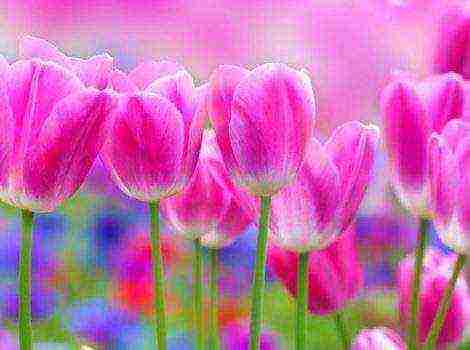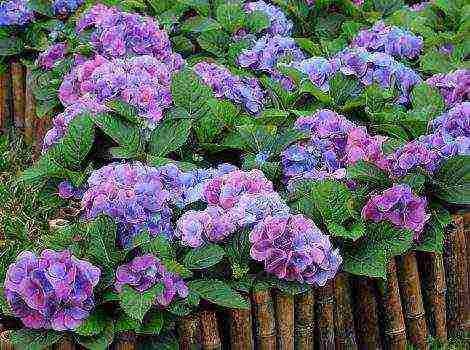Content [show]
Bright phloxes are very popular among summer residents and experienced flower growers due to their unique beauty and unpretentious care. But in order for elegant flowers to please the eye for longer than one season, phloxes need special care in the fall and proper preparation for winter.

Features of phlox care in the fall and preparation for winter - general tips and tricks
In order for the plant to please with lush flowering in the upcoming season, it needs to devote a little time and effort. What does phlox need in the fall for normal development?
Watering... If it's a dry autumn, the bushes need to be watered regularly: 1 sq. m landings you need to make 2 buckets of water. During watering, you need to adhere to the following rules:

- Watering phlox should be done in cloudy weather, in the evening or in the morning.
- To avoid infection with fungal diseases, water only the soil around the flowers, leaving the stems and leaves dry.
- On hot days, the plants are watered with lukewarm water.
Moisture is very important for the well-being of plants and successful wintering, therefore, the soil should not be allowed to dry out too much.
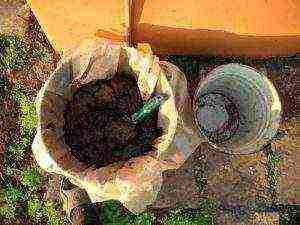
Top dressing. In the last month of summer, the plant is no longer fed with fertilizers with a high nitrogen content. A similar growth stimulator is replaced with phosphate-potassium supplements. Fertilizers are applied in the fall as follows:
- Phloxes are watered abundantly - this will restore the water balance of the roots, and also prevent the rapid freezing of the soil.
- A few days later, when the soil dries out a little, the bushes are sprayed with fungicides.
- 2 weeks after treatment for diseases, plants are fed with a large amount of phosphorus and potassium. To scare away insects, a small amount of wood ash is applied under the bushes.
Worth knowing! It is better to feed early phlox varieties with nitrogen-potassium fertilizers, later ones - with nitrogen-phosphorus fertilizers. In both cases, the nitrogen content in the fertilizer should be minimal.
Loosening and weeding. Full care of lush flowers in autumn cannot be carried out without timely loosening of the soil and removing weeds. Please note that you need to loosen the soil very carefully, since the underground part of the plant is located close to the surface.
Mulching. The roots of phlox are very poorly buried and often peek out of the soil, so they must be covered before winter, since a significant drop in temperatures will lead to freezing of the soil without snow cover and destroy the bush.

Rotten manure, peat, dry compost can be used as mulch. Most growers shelter flower bushes horse manure: it perfectly emits heat and nourishes perennial plants. The root soil is mulched immediately after fertilization. To make the root system feel comfortable even in the most severe frosts, it is enough to pour 2/3 of a bucket of organic material under one bush.
Pruning. In order to prevent diseases and pests, the stems of the plant are cut, leaving a stump with a height of 2 to 20 cm. Pruning is carried out some time after the end of flowering: during this time, all valuable substances are directed from the stems to the roots.
Shelter. In a changeable winter, most of the plants in the garden need to be insulated before winter. Shortly before the onset of frost, phlox plantings are covered with a layer of mulch 8-12 cm thick. Organic material will not only protect underground buds and rhizomes from freezing, but also serve as a valuable fertilizer.
Video: preparing phlox for winter
Pruning phlox in the fall
Removing stems is a very important step in the autumn care of most of the plants in the garden, including flowers. Is it advisable to prune phlox in the fall, and how to do it so as not to harm them?

Why prune phlox
Phlox are pruned, as a rule, in pursuit of the following goals:
- Removing the aerial part of flowers is an excellent prevention of fungal diseases.
- Together with the stems, the pests accumulated on the brilliant green are destroyed.
- A layer of mulch will prevent the roots from freezing, which grow upward and often become bare.
- Cultivated plantings are less problematic to spray and mulch than plantings with a solid top.
- After flowering, all nutrients pass into the root and remain there, which allows the plant to winter safely.
- Trimming the stems prevents the formation of weak stems.
When is the best time to prune phlox - in autumn or spring
According to experienced florists, you need to cut off the stems of phlox in the fall before the onset of cold weather... Correctly performed garden manipulation will prevent the development of diseases and the attack of insects, and also make the plant healthier.

If the bushes grow in the northern or southern part of the country, it is recommended to cut the stems in early spring: the ground part will trap snow, which will warm the roots and fill them with moisture.
Timing of pruning phlox in the fall
The best time to cut elegant flowers is chosen based on the varieties grown: early bushes are cut in September, late - in October... Please note that manipulation should be started only after the bush has completely bloomed, and the nutrients from the green part will go down to the roots. You need to finish the autumn pruning before the establishment of permanent frosts.
Video: when to cut phloxes in the fall for the winter
How to properly cut phloxes in the fall - instructions and diagram
There are several schemes for pruning phlox:
- The ground part of the plant is cut off at a height of 1-2 cm from the ground. After the complete removal of the stems, the risk of contracting diseases disappears, the pathogens of which have gathered on the ground part during the season. For the same reason, the plant is less susceptible to insect attack.
- The stems are cut, leaving 8-10 cm of hemp... As a result of using this method, young shoots develop from the remaining buds in the spring. However, in practice, they often develop poorly and bloom much worse than those that grow from the root.
- After pruning, hemp is left with a height of 10-20 cm... Despite the fact that such a scheme is most popular among gardeners, it has several disadvantages: insects and pathogens remain on the remaining ground part, the plant is rather difficult to spray and mulch.
According to the latter scheme, it is best to cut off phlox growing in the north and south: hemp well hold snow over the roots and protect them from the cold, fill them with moisture.
Based on the above characteristics, the use of the first and third schemes is most justified.
Video: how to cut phlox in the fall
Care after pruning phlox in the fall, feeding them
In order for the autumn pruning to be good for phloxes, you need to properly care for after manipulation. The sequence of actions should be as follows:
- On the site, organic waste is raked up and burned away from cultural plantings.
- To prevent the development of diseases, the soil around the plants is sprayed with fungicides.
- Before feeding, the plant is watered abundantly.
- 1 tbsp is applied under a flower bush. l. superphosphate mixed with a small amount of ash.
Shelter phlox for the winter
Phlox is a relatively frost-hardy culture that can hibernate without shelter, growing in a mild continental climate. But even during warm winters, there are short-term strong cold snaps that can destroy the buds and roots of the plant: the fatal temperature for the aboveground part is -15 C, for the underground part -20 C.
Not only severe frosts, but also long thaws are dangerous for perennials: the plant reacts to heat and quickly dissolves buds, which suddenly freeze after the resumption of subzero temperatures.
Do I need to cover phloxes for the winter
To protect the buds from possible frosts and prevent them from blooming during a period of short-term warming, plantings must be covered. Phloxes, which do not have good cold resistance, as well as recently planted plants that have not yet matured, are especially in need of mulching.

How to properly cover phloxes for the winter
Covering phloxes before winter is very simple: flowers prepared for winter are covered with a 10 cm layer of peat, compost or humus. In order to insulate one plant, it is necessary to scatter about one bucket of mulching material around the perimeter of the root system. In order for the snow to linger longer over the bush, the mulch is covered with spruce branches, large tops.
Important! Do not cover phlox with airtight materials (foil, roofing felt, linoleum). Prolonged lack of air and moisture will lead to the development of rot.
The shelter must be removed in early spring, as soon as the risk of severe frosts disappears.
What are the features of preparing a plant for winter in different regions
The severity of the shelter before winter depends on the weather conditions of the growing region. An individual approach will help plants survive safely until spring, even in the Far North.
In the middle lane
Since the Moscow region does not differ in an extremely harsh climate, for successful wintering, phloxes are cut to a height of 2-5 cm, and then they cover the soil above the roots with a bucket of rotted manure.
In the Volga region
In this region, preparation is carried out according to the same scheme, only the height of the stumps increases to 8-10 cm, and tops or branches are laid on top of the mulch.
In the Urals
Phloxes harbor as well as in the Volga region. And throughout the winter, additional snow is thrown onto the bush.
In Siberia
In the northern region, phloxes are not cut off, mulch is poured over them and spruce branches, corn and sunflower tops are laid. Some gardeners, for greater confidence in the successful outcome of wintering, dig up bushes and place them in containers, which are lowered into the basement until spring.
Video: preparing phlox for winter - digging
Typical mistakes in phlox care in autumn and in preparation for winter
Below are the most common mistakes, having familiarized yourself with which, you can prevent deliberately incorrect actions that adversely affect plants:
- Phloxes are fed with nitrogen fertilizers. A large dose of nitrogen stimulates the plant to form shoots, as a result of which the bushes lose nutrients and weaken greatly.
- Untimely shelter for the winter. No need to insulate phloxes if warming is still possible. Shelter of bushes should be done before the onset of frost.
- Planting of perennials is covered with dense materials. The lack of air and moisture leads to the development of rot, which quickly destroys the plants.
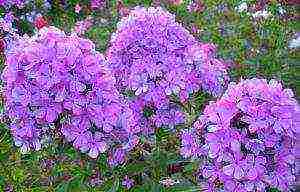
Proper autumn care is the key to successful wintering and amazing beauty of phlox in the coming season. Elegant lush flowers will gratefully take care and become the main attraction of the garden.
Phlox are perennial flowers that delight in the summer with a rich palette of colors, dense rosettes and unpretentious care. A light and unobtrusive aroma throughout the entire flowering period only makes phlox even more popular in the flower beds of most gardeners.
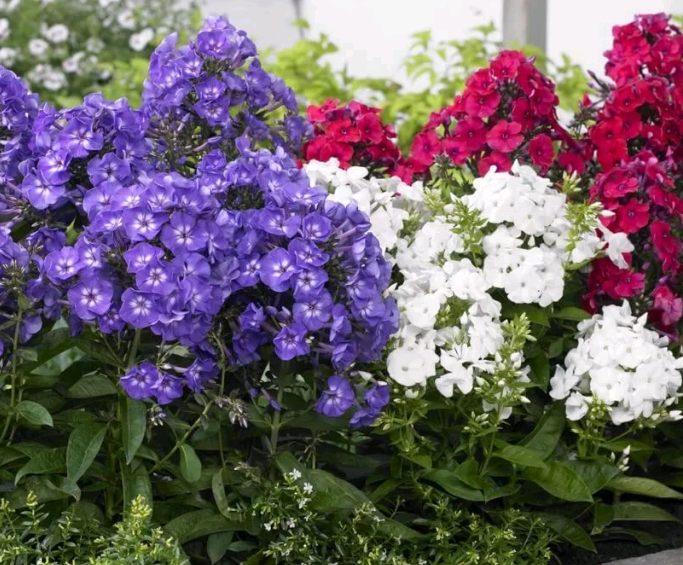
Training
Phlox, as well as numerous other perennial plants, have aerial stems dying off in winter. In autumn, with the arrival of frost, their intensive growth stops. Nutrients from the leaves and shoots are transferred to the root system over time. At the same time, phloxes undergo hardening - preparation for winter proceeds, preceding the final drying of the complete upper lobe of the plant.

To own long-term blooming flowers in your own garden, you need to organize them in a special way for the winter period. Autumn phlox care contains a large set of events aimed at preparing phlox for winter:
- Providing absolute withdrawal of nutrients to the roots;
- Prevention of disease and pest infestation;
- Stimulation of the upcoming vegetation
- Preservation of the root system from freezing.
Pruning flowers correctly for winter
Phlox, as well as other perennials, in which the ground share dies off with the arrival of frost, it is preferable to cut it in winter. This is one of the stages of preparing phlox for winter. When choosing the best period for the purpose of pruning phlox in the winter, one should start from whether the plant is considered to be early flowering or late flowering. Pre-flowering phlox species wither more rapidly, and their cut is done immediately after the end of flowering in late summer - early autumn.
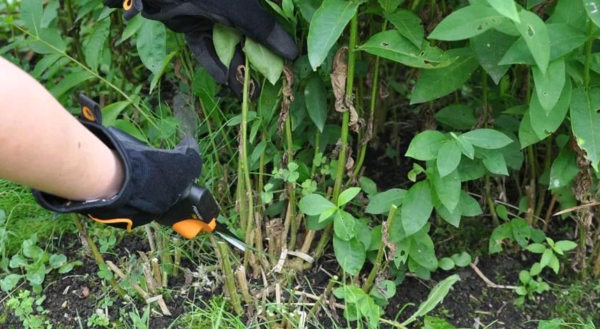
Types of phlox, which start to bloom late, wither as usual by the end of September, therefore, the cut is made about a month later. The only recommendation according to the pruning period is to carry it out until stable cool weather is established. In temperate climates, this is the beginning or half of October.
We meet winter
- The ground share of the bush is pruned with a garden pruner, keeping segments from 5 to 10 cm from the ground level;
- Such stumps should be preserved, since at the base of the shoots there are 2 - 3 recovery buds, from which young shoots hatch with the arrival of spring. In addition, the rest of the cropped branches are considered markers suggesting the place of planting of perennials.
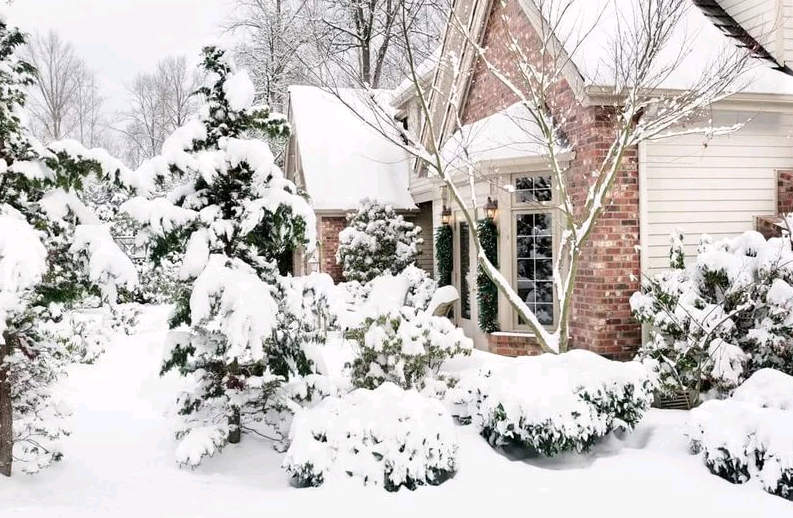
As a rule, old phlox species, accustomed to rather severe winters, tolerate wintering well. And, if, according to forecasts, a cold and snowy winter is guaranteed, in this case phlox will winter well in the absence of shelter. But many new breeding species, especially derivatives in areas with a rather mild climate, need to be insulated, including in mild winters.
If the winter is supposed to be cold, and most importantly, little snow, bushes of absolutely all types of phlox should prepare a warming shelter.
Algorithm for preparing flowers for winter
- In dry and warm weather, it is worthwhile to carry out the obligatory treatment of plants and soil near plantings with special fungicides. They allow you to get rid of pests and diseases;
- After 14 days, 1 tbsp is poured under the phlox bush. spoon of superphosphate and wood ash. This will help the plant to move away from winter faster in spring and start growing;
- Immediately after replenishment of flowers, mulching of flowers is performed in order to insure them against freezing of the root system or its partial loss. For this purpose, good peat or mature humus is ideal. Experts believe that horse manure is ideal for this task.Its specificity is that in the process of decomposition of the components, this manure heats the soil. Each bush will need about half a bucket of manure or three quarters of a bucket of peat. Thus, the embankment is carried out, "bumps" are formed;
- Spruce branches, brushwood or tops of garden plants or vegetable crops are laid on top of the "bumps". This is done to maintain an acceptable temperature and retain snow;
- With the arrival of the first warm spring days, the cover of spruce branches or tops should be removed. This will protect young shoots from insects. It is not necessary to hide the shoots with a layer of polyethylene or roofing material for the purpose of warming, since phloxes under such a shelter get wet and vytryat. This leads to the death of the plant, and can also lead to disease and death of neighboring plants.
Care after wintering
Stages of transferring a plant from hibernation to spring period:
- Like any other plant, phlox looks unattractive after wintering. Our goal is to help the flower regain its own pristine beauty. Our support will consist in fertilizing and mulching the soil;
- If we talk about top dressing, in this case, in the middle of spring, it is allowed to irrigate phlox with a weak solution of humate or complex granular fertilizer. As a result of this kind of feeding, the formation of the plant will accelerate. During the same period, it is recommended to loosen the soil, and mulch it with a fertile layer of earth or compost;
- Plants that have not survived wintering are removed to avoid cross-infection of the bushes.

In order for the flower garden to delight you every year, you need to properly prepare phlox for winter.
New publications:
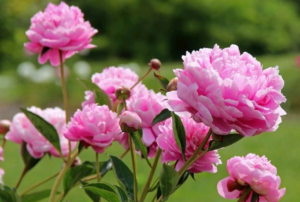
Of the whole variety of garden plants, peonies occupy one of the first places in the plots of summer residents. It's all about their luxurious colors ...

Tulips are one of the plants that fill our cities and gardens with the beauty of spring. At the same time, it is one of the most ...

Roses are beautiful, unpretentious, perennial plants. There are more than 35,000 varieties of roses. Modern varieties are more resistant to diseases, but there is a variety, ...
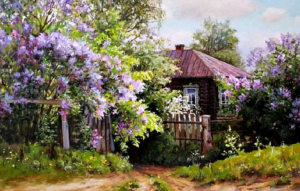
Most gardeners imagine their garden with lilac bushes. White, lilac, pink - you can't choose which one is more beautiful. During the flowering of lilacs ...
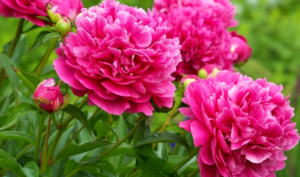
Peony is a perennial, herbaceous plant that has its own characteristics and growing rules. Peony flowering - appreciated by many gardeners, for its ...
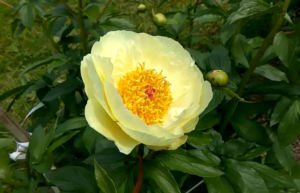
Everyone can decorate the garden with perennial, unpretentious flowers. But modern gardeners are increasingly making new demands on flower varieties: resistance to ...

In the summer, every person goes to the countryside or to the country at least once every three months. But it's worth ...

Roses are perennial plants with an incredible number of varieties - more than 30 thousand. There are monochromatic, multi-colored with rolling shades or with ...
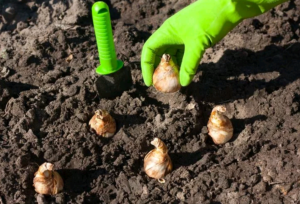
Florists who are just starting out, often face a lot of problems when planting and caring for a flower. Narcissus is pretty ...

Tulip is a perennial bulbous plant that belongs to the Liliaceae family. It became known in the Middle Ages - mainly tulips ...

It is difficult to imagine that any garden or balcony without unpretentious flowers is petunias. One of the species conquers the hearts of more and more ...
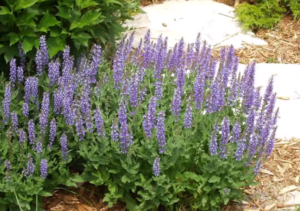
Salvia Divinorum or sage is a perennial semi-shrub plant. For the first time Salvia Divinorum was discovered in 1939 by researcher Jean Bassett Johnson ...

Who among us, who have our own piece of land, is trying to ennoble it not only with vegetable crops, but also to decorate it with flowers and herbs, ...

Most people who have a garden plot have roses planted, but not everyone knows: which group they belong to, how correctly for ...
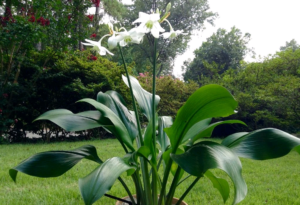
The Amazonian lily (Eucharis), blooming not on the windowsill, but in the garden, will become an unusual decoration for an annual flower bed. With good care, you can get ...

Rose is the mistress of women's hearts, to have such a flower in your own garden at your summer cottage is not a luxury, but everyone's duty ...
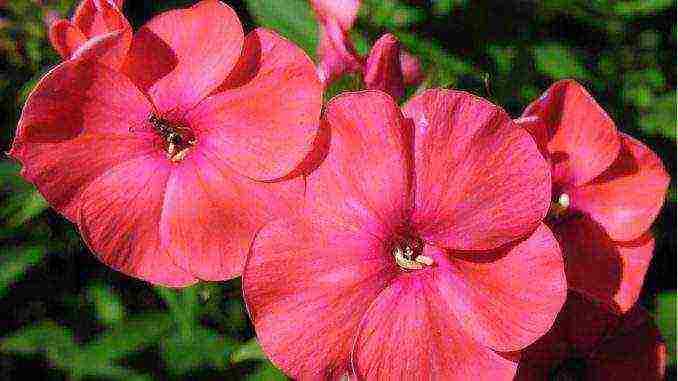
Perennial phlox is a lush flower with a bright aroma native to North America. The name of the flowers was given by Karl Linnaeus, it translated from Greek as flame... In culture, 40 species and more than 100 varieties of phlox are grown.
Description and characteristics of perennial phlox
The plant is a bush with straight stems and oval leaves. The height of the plant, depending on the species, ranges from 10 to 150 cm.
The stem ends in an inflorescence, which can contain up to 90 flowers. The tubular flower has five petals. The colors are varied, mainly pink, purple, blue shades are popular.
 Phlox color variety
Phlox color variety
After flowering, seed pods are formed.
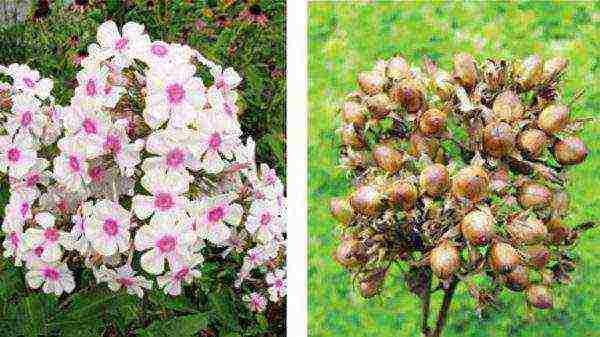 Mother plant and ripe seed pods
Mother plant and ripe seed pods
Varietal variety
Perennial phloxes can be divided into two large groups: ground cover and bush... Each group has its own species and varieties. In total, more than a hundred different varieties have been bred.
Groundcover
Low-growing flowers have a height of 10 to 40 cm. They are used in border compositions, alpine slides and balcony boxes. Types and varieties:
Subulate
It is named so because of the pointed shape of the leaves. Plant height 20 cm. It completely covers the flower bed with its bright flowers. It blooms twice - in May and August. Varieties:
- Mayishne - white color;
- Tellaria - lilac petals;
- Thumbelina - pink color;
- Candy Stripes - pink petals with white edging.
Douglas
The stems of this species reach only 10 cm in height. Blooms from May to June. This species is also called "moss carnation" because the thick, crowded stems after flowering resemble forest moss.
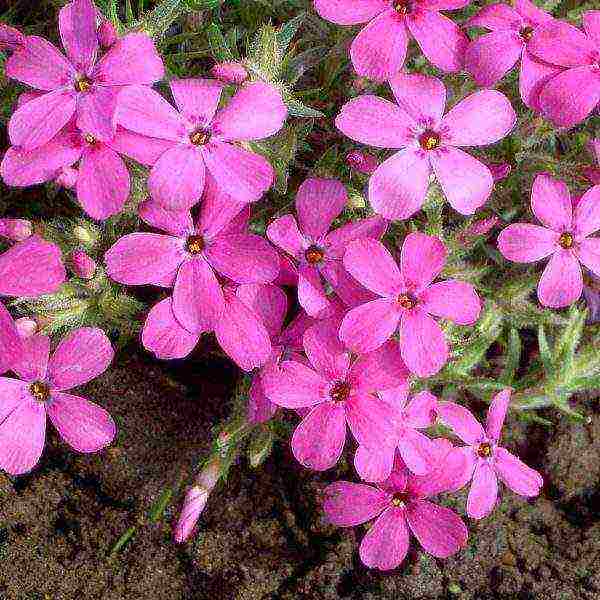 Phlox Douglas
Phlox Douglas
Forked
The stems are thick, the flowers are white or blue. The species is named so because of the shape of the petals. They bifurcate at the ends, giving the impression that there are twice as many of them.
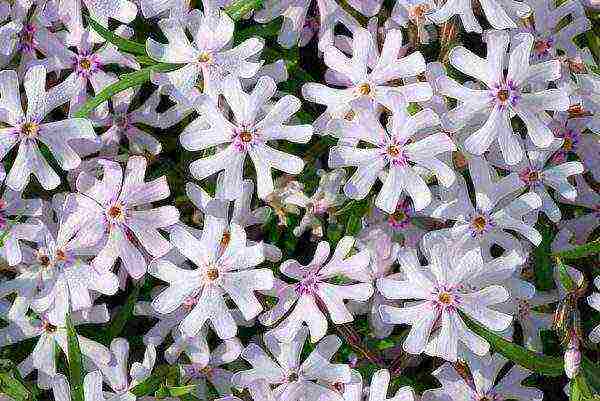 Phlox Forked
Phlox Forked
Bush
Bush phlox can be short and tall... This is the most common group of flowers that are grown in urban flower beds and gardeners' plots. The flowers are large, fragrant, bright saturated shades. The most common variety is paniculata phlox., it blooms in mid-summer and continues to bloom until autumn.
 A bright representative of paniculate phlox, cultivar Success
A bright representative of paniculate phlox, cultivar Success
Tall
- Windsor... Height 1.5 m. Grows best in sunny areas. The color is white and pink.
- Star of Paris... Blue flowers with thin lilac veins. Height 90-100 cm.
- Natasha... Petals in two colors - white and lilac. The height of the bush is 1.5 m.
- Larissa... The middle of the flower is purple, the edging is white, the edges are pink.
Undersized
- Delilah... Large purple flowers. Height 50-60 cm.
- Laura... The petals are lilac with a white center. Height 60-80 cm.
- Pet Mike... White petals with a pink center. Height 50-70 cm.
- Nicky... Velvety petals of deep purple color. Height 60-80 cm.
These are just some of the varieties that you will find in stores. Many more species have been bred by breeders, with various colors of the petals and the middle of the flower.
When choosing a variety, consider the place where you will plant it. The height of the bush and color should be chosen correctly to create an organic floral arrangement.
Reproduction methods
You can propagate these plants in three ways:
Seeds
They are harvested in the fall, when the leaves of the plant have already wilted. The ripe capsule is brown in color, the seeds in it are dark green. They are planted immediately after harvest, as they quickly lose their germination.
Seeds are sown directly into the ground at a permanent place. It is advisable to choose lighted areas, although some varieties are resistant to shading. The place must be protected from drafts... It is advisable to plant them in loose soil, phloxes do not like sandy and acidic soils.
Planting lasts from October to January. You can plant them when the snow has already fallen, you just need to clear the area from it. The distance between the seeds should be 5 cm. They are laid out on the soil, lightly sprinkled with earth and snow.
 Phlox seeds
Phlox seeds
By cuttings
You can root cuttings in spring and autumn. With this method of reproduction, varietal characteristics are preserved even in rare phloxes.
In the spring, a mother bush is chosen, on which young shoots have reached a height of 15 cm. Selected shoots are cut and divided into cuttings of 5-7 cm. Each of them should have 1 pair of leaves. The sections are treated with a root stimulant.
The cuttings are rooted in a greenhouse or in a box. Mix equal parts of soil, humus and sand. The soil is watered, and a layer of river sand 2 cm thick is poured on top. Shoots are planted so that their lower edge is in the sand, does not touch the soil. Seedlings are covered with foil and sprayed regularly.
Rooting takes 3 weeks, after which the shoots are hardened and planted in a permanent place.
Cutting in the fall is carried out in a similar way. In early September, after flowering, the shoots of the current year are cut off. They are rooted in greenhouses according to the above scheme. In the spring they are planted in a permanent place.
Dividing the bush
This is the easiest way to reproduce. You can carry out the procedure at any time, except for flowering. You can divide the mother plant in the fourth year of life.
The bush is dug up and the shoots are cut to a height of 15 cm. With a knife or a shovel, it is divided into several new bushes so that each one has buds to resume growth. New bushes bloom next year.
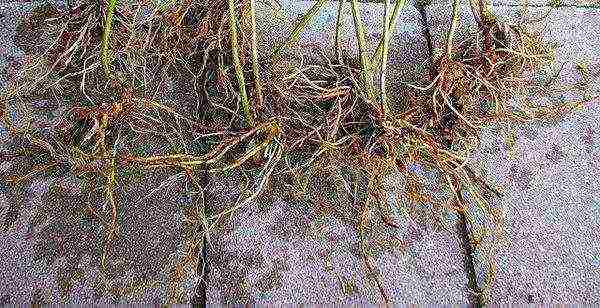 Split phlox bush
Split phlox bush
Landing
For lush flowering and rapid growth, phloxes need sunlight, loose nutritious soil, and protection from drafts. These plants are considered quite unpretentious, but it is best to prepare the site well before planting.
A year before planting the plant, it is advisable to fertilize the soil with organic matter: ash, manure, compost. Clay and heavy soils are best lightened with sand and peat. Sod, manure or compost should be added to sandy soils.
It is better to choose a sunny area near the fence, where there are no drafts. Shade-tolerant varieties can be planted under trees and bushes.
If you plant phloxes on the north side of the house, where there is no sun, their flowers will be small and scarce.
You should only buy cuttings and seeds from trusted locations. Before buying a seedling, pay attention to the root, it must have healthy buds, as well as 2-3 stems.
Seedlings can be planted outdoors in mid-April-May. After planting, they need to be watered abundantly; in summer, watering is reduced. Phlox is also planted in September before the onset of frost. They can bloom in the spring. In summer, flowering seedlings are planted immediately. After planting, the peduncles are cut off, the bush is watered every day.
 Phlox seedlings
Phlox seedlings
When planting, keep the distance between plants. For low-growing varieties - 30 cm, for tall ones - 60 cm.
It is recommended to divide the bushes and replant them to a new location every 4 years.
Care
Unpretentious phloxes should be regularly watered and loosened, weeded and fed. You also need to pay attention to diseases in time and treat them.
Watering
This plant loves moisture. It is advisable to water it every 2-3 days. This should be done more frequently during dry summers. Along with watering, you should remove the weeds around the bushes and loosen the soil.
Top dressing
Fertilize the plant regularly to improve flowering. In the spring, during the period of active growth, nitrogen fertilizers are applied to the soil. During flowering, it is advisable to feed phlox with potassium or phosphorus preparations. In the fall, before frosts, the soil is fertilized with phosphorus agents. All dressings are carried out early in the morning or in the evening.
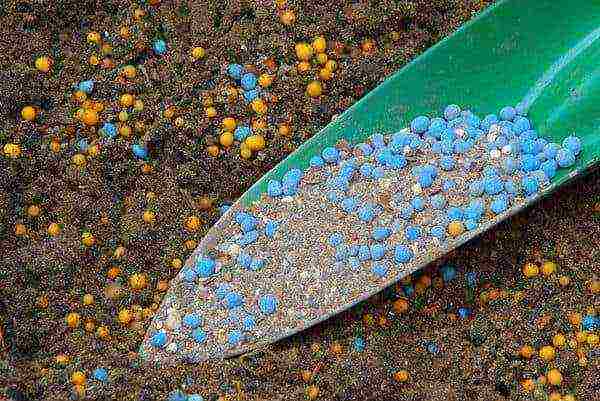 Fertilizing phlox
Fertilizing phlox
Preparing for winter
In the southern regions, no shelter for phlox is required. In central latitudes, it is advisable to shelter them for the winter. In autumn, with the onset of frost, withered stems are cut, the soil is mulched, the bushes are sprinkled with straw or covered with a special material. For the northern regions, it is recommended to dig up the bushes and store them in boxes in the basement.
Diseases and pests
Phloxes are affected by the same diseases as other garden plants:
- Fomoz... During flowering, the plant leaves turn yellow and curl, the stem turns brown and cracks. To combat the disease, the bushes are treated with Bordeaux liquid 4 times with an interval of 10 days.
- Powdery mildew... A white bloom appears on the leaves. To combat it, use Bordeaux liquid or other drugs. The affected leaves are removed. For prophylaxis in the spring, you can spray the shoots with potassium permanganate.
- Septoriasis... Gray spots with a brown border appear on the lower leaves. For treatment, the plant should be treated with the "Profit" preparation.
- Leaf spot... Yellow spots appear on the leaves. For treatment, remove the affected areas and spray the plant with a 1% solution of Bordeaux liquid.
The lower leaves of the plant may turn yellow and fall off due to lack of watering.
First, try to increase watering, if this does not help, then start treatment with drugs.
Most often, the following pests feed on parts of phlox:
- Slugs;
- Nematodes;
- Slobbering pennies.
Getting rid of them is difficult, so damaged bushes are dug up and burned. After that, the soil is carefully loosened and sprinkled with ash. The leaves can also serve as food for caterpillars and butterflies. To destroy them, you can buy any drug for gnawing pests.
Perennial phloxes are excellent plants for city flower beds and parks, for garden compositions, as well as for alpine slides... They perfectly coexist with other perennial flowers: roses, lilies, tulips, irises.
Phloxes are a popular variety of perennial flowers that many summer residents plant on their plots. However, when growing them, it is necessary to know the peculiarities of caring for this plant, especially in the autumn period, since the quality of flowering for the next season will depend on it. All the features associated with this process will be discussed in detail in this article.

Features of phlox care in autumn
Autumn care for phlox usually involves performing the same sequence of actions, regardless of the location and characteristics of the cultivated varieties, therefore, to simplify the understanding of this process, an approximate schedule of actions is given below:
- It is necessary to start autumn care in late September or early October, depending on the climatic characteristics of a particular region. At the initial stage, a complex treatment of plants and flower beds as a whole is carried out with various prophylactic drugs that create protection against the main varieties of parasites and various fungal formations.
- You can start the next stage in 1.5-2 weeks, it will consist in introducing complex bait mixtures into the soil of the flower bed. In the autumn, phloxes especially need phosphorus and potassium, which make them easier to tolerate the winter.
- Pruning bushes is a must-have for fall maintenance., it is usually carried out from 10 to 20 October.
- Mulching is usually carried out immediately after the realized pruning of the bushes.
- At the final stage, the phlox is being prepared for the upcoming winter., for this, an insulating shelter is being built, which must not be forgotten to be dismantled in a timely manner in the spring.
Post-flowering care
Different varieties of phlox differ in the timing of flowering, immediately after its completion, it is required to immediately provide care, which will consist in the following:
- Cutting plants: all dried inflorescences are removed, the bushes are trimmed, they must be shortened by about a third of the total height.
- Introduction of fertilizing mixtures into the soil, for this 20 gr.superphosphate and 10 gr. potassium salt is diluted in a bucket of water.
- Additionally, you can add flower beds to the ground pre-ground wood ash.
- Top dressing with any mixtures with a high level nitrogen content should be excluded.
- Weed growth at this time slows down, but they must still be removed in a timely manner. At the same time, not only the ground part is eliminated, but also the root system, since it may contain pests that can overwinter in this way in a flower bed.
- Fungicide treatment is carried out only if necessaryif it is known that plants in this area can be susceptible to various fungal diseases.
- Soil mulching must be carried out without fail after all fertilizers and fertilizing mixtures have been added to the soil. For this procedure, it is best to use a mixture consisting of horse manure, dry humus of plant origin and peat, all components are mixed in equal proportions. The amount of mulch used should be about a third of the bucket for each bush.
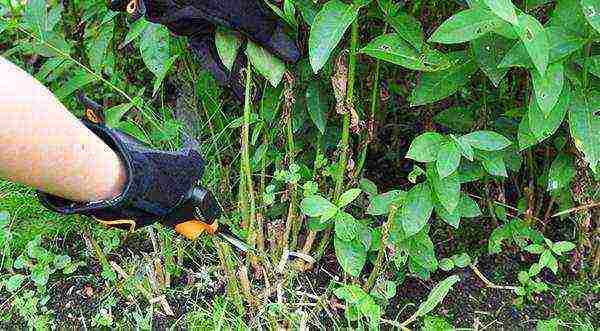
Watering in autumn
Phloxes like to grow in moist soil, it should not be allowed to dry out, since this will negatively affect the condition and health of plants.
In the fall, the bushes also continue to need watering, the rules for its implementation are given below:
- Watering is recommended in the evening or morning hours.
- The volume of water should be selected in such a way that the root processes have the opportunity to quench their thirst along their entire length. To do this, you will need to use at least two buckets of water for each square metro of phlox plantings.
- If the fall is warm enough or there are some hot days, then, as in the summer, you will need to make sure that the water used is not too cold.
- Watering is carried out around the bush, it is necessary to completely exclude the ingress of moisture on the trunk or foliage. Particular attention should be paid to this when watering a flower bed if there are diseased plants on it, since violation of this rule can lead to further active spread of the disease.
Autumn watering should not be neglected, especially in case of rare precipitation, since phloxes should go to winter well moisturized, which will allow them to survive this period without any special incidents.
For the same reason, mulching is also required: the created layer will help to retain moisture, so that phloxes will not feel and suffer from a lack of liquid.
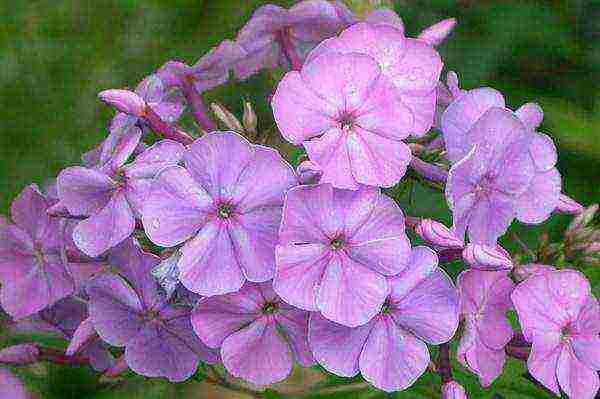
Top dressing in autumn
Feeding of these plants is carried out practically throughout the entire season, but in the autumn period it has certain nuances. All the features of this part of flower care are given below:

- With the onset of autumn, a fertilizing mixture is introduced into the soil high in potassium and phosphorus, just like in late summer.
- An additional mixture is prepared, consisting of a double dose of superphosphate and wood ash, but it is allowed to be applied only in the free space on the beds between the bushes.
- For early varieties, you can use nitrogen-potassium store fertilizers., but the nitrogen content in them should be minimal.
- For later varieties, nitrogen-phosphorus fertilizers are better suited., but the nitrogen content should again be negligible. The use of exclusively nitrogen mixtures is strictly prohibited for all varieties.
- It is recommended to use complex mineral fertilizers for both root and foliar dressing. They are rich in various trace elements that will ensure abundant flowering for the next season and maximize the resistance of plants to various diseases.
In this case, not only the correct choice of mixtures is important, but also the observance of the basic rules, which are given below:
- Any feeding mixtures are introduced into the soil only in the evening hours. regardless of the season.
- All varieties of root dressing mixtures in liquid form are applied only after abundant watering.
- Fertilizers produced in dry form are best used on cloudy days if a large amount of precipitation is predicted., which will allow nutrients to enter the deepest soil layers in a natural way.
- It is necessary to monitor compliance with the dosage, since applying too little fertilizer will not bring a positive effect., phloxes will feel a lack of nutrients. At the same time, overdoses should not be allowed, which will also negatively affect the health of plants and their flowering for the next season.
- The application of fertilizers, regardless of their type, to completely dry soil is strictly prohibited.
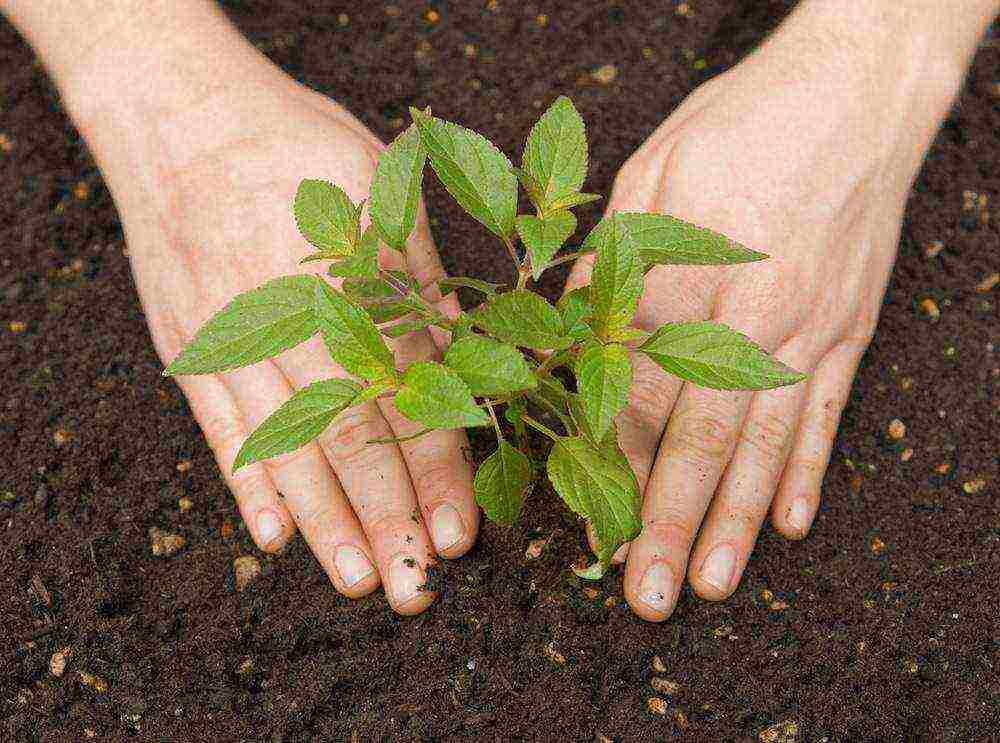
Phlox transplant in the fall
Transplanting bushes, which is carried out in the autumn, can occur for several reasons: the expiration of the permissible period for growing phlox in one place or the presence of any factors that require their early transfer to a new site.
Regardless of the reasons for the need to perform this procedure, it should be carried out as follows:

- Initially, transfer holes are prepared at the new location; this must be done at least 2 weeks before the planned transplant. This period will be enough for the soil in the chosen place to settle naturally and damage the root processes of the transplanted flowers.
- The diameter and depth of the pits is determined by the size of the transplanted bushes and their root system, they usually depend on the age and characteristics of the variety. The distance between the different holes should be at least 60 cm, but when growing miniature varieties with a small height, this indicator can be reduced.
- The bush must be pruned beforehand., the length of all shoots should not exceed 10-15 cm.
- Around the perimeter, the bush is dug in with a shovel, after which, with the help of a garden pitchfork, it is hooked along with a lump of soil. These actions must be carried out with the utmost care so as not to apply root system damage at such an inopportune moment.
- If dividing the bush is supposed, then it is carried out at this stage with the help of a sharp tool, in this case, it is necessary to check that each received part has from 2 to 5 buds of renewal, otherwise it will not take root in a new place.
- Before transplanting, add half a bucket of compost to each prepared hole, as well as any suitable varieties of mineral feed mixtures. The only requirement is to carefully study the composition - nitrogen must be excluded from it without fail, otherwise the risk that phloxes will not survive the coming winter increases.
- All holes are also allowed to lightly sprinkle with wood ash., it will provide plant nutrition with potassium and its derivatives.
- When transplanting into soil with a high acidity level, it is requiredAdditional application of lime to the soil, the volume is equal to one glass.
- Each hole is abundantly moistened, after which a bush is carefully lowered into it. It is necessary to check that all root branches are correctly positioned and do not have unnatural bends.
- After that, the holes are filled with garden soil, it must be carried out in this wayso that all renewal points are 3-5 cm deep.
- After digging holes, the soil at the landing site is additionally compacted and compacted. A small amount of compost is added to it, after which tamping and compaction is carried out again.
- This completes the planting of phlox in a new place., it remains only to mulch the soil.
Diseases and pests and methods of their treatment
Phloxes are often susceptible to various diseases or pests, the main ailments of these plants, as well as methods of combating them, are discussed in more detail below:
- Stem nematode is the most dangerous pest species that can attack phlox. Under its influence, the upper parts of the shoots become thin, weak and gradually deformed. With the growth of the population of these pests, the bush completely dies, therefore, prompt action is required. To do this, all affected shoots and other parts of the plant must be cut off in time, after which they are burned to prevent the spread of nematodes throughout the site. At the end of spring, a transplant of the bushes on which this pest was noticed must necessarily be carried out; it is best to use the alternation technique so that the seedlings are guaranteed healthy. In the place where the infected phlox grew, it is recommended to plant marigolds or nasturtiums.
- Powdery mildew is a disease to which many garden plants are susceptible, its main manifestation is the appearance of a characteristic specific plaque on the branches and leaves of the plant. In most cases, the main symptoms appear precisely in the fall, measures must be taken promptly in order to have time to cure the flowers before the onset of winter cold weather. There is only one method of getting rid of powdery mildew - it is required to spray the affected bushes from a spray bottle with special solutions, which include copper or soda ash. Also, water is suitable for processing, to which liquid soap has been added, or a solution of potassium permanganate.
- Verticillary wilting is another common disease that causes the leaves to change their color and begin to gradually fade. This is an external manifestation of the disease, but its main reason lies in the defeat of the root system by certain types of fungal formations that are the causative agents of this disease. In this case, complete removal and disposal of the affected plants is required, while a large lump of soil around them is also subject to destruction, since fungal spores can remain in it. After the implementation of this procedure, liming of the earth in the flower bed is mandatory. For the prevention of the disease, it is recommended to treat all phloxes before planting with special preparations; Maxim and Gamair are best suited for this.

Preparing for winter
Phloxes are considered a frost-resistant plant; a thick layer of snow is natural insulation for them. However, winter can be quite cold and at the same time little snow, in this case, a long stay in a low temperature regime can be detrimental to these flowers.
For this reason, a set of measures is required to prepare for the impending cold weather:
- Initially, the maximum pruning of the bushes is carried out, it is necessary to keep only small stumps 5-10 cm high.
- Mulching of the soil is carried out, for this you can use the previously described mixture of humus, peat and horse manure. In this case, it is necessary to ensure that the humus is completely dry. You can also use fallen leaves or the remains of bushes obtained after pruning as mulch.
- From above, the plants are covered with any suitable insulation material, the most suitable option is spruce branches.
- From additional shelter with roofing materialas is done for many plants, it must be discarded.
- In the spring, it is required to remove the created shelter in a timely manneras overheating of phlox can also be detrimental.
Dividing a phlox bush Main mistakes
Below are the most common mistakes that are made during the autumn care of phlox. Timely familiarization with them will prevent possible repetition of them in the future:
- Adding large amounts of nitrogen to the soil. It can provoke unnecessary growth of root shoots and shoots in winter, which will take away from the plant a large amount of strength and accumulated nutrients and can lead to the death of phlox.
- Failure to comply with the terms of the organization of the insulation shelter. It should be installed only at the moment when thaws are no longer expected, but before the arrival of the first serious frosts.
- Adding individual components to the soil, necessary to create bait mixtures or liming the soil. All ingredients are mixed before being added to the soil and thoroughly mixed to obtain a homogeneous mass, otherwise there is a risk of root burns.
Tips for florists
Summing up, you can give the following recommendations that will be useful to growers who grow phlox in their areas:
- In the fall, you can additionally feed with liquid feces, but such fertilizers are not recommended for plants that have been transplanted to a new location.
- Meadow geranium, daylilies andiris can become not only good neighbors for phlox, but their joint landing on the same site is also allowed.
- For preventive treatment in the fall, it is best to use the preparations "Fundazol" or "Fitosporin-M". They may not always be found on the market, but these options are the most effective.

